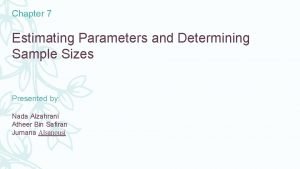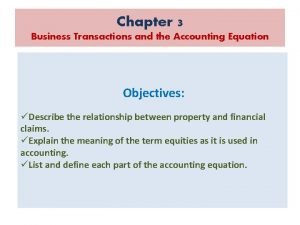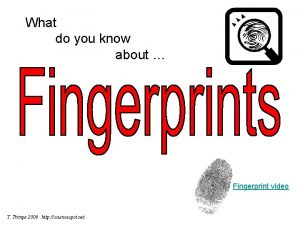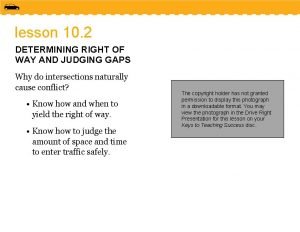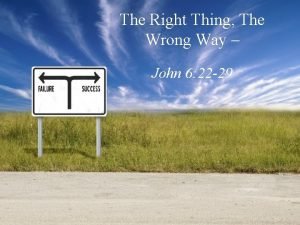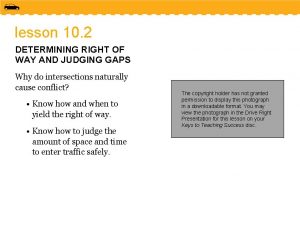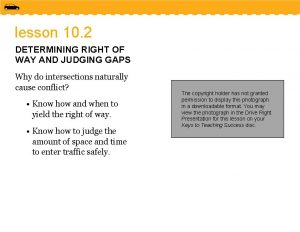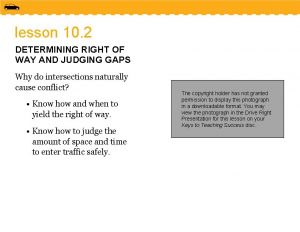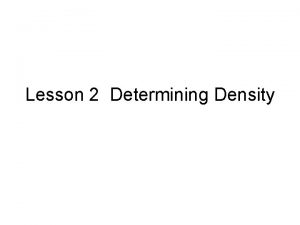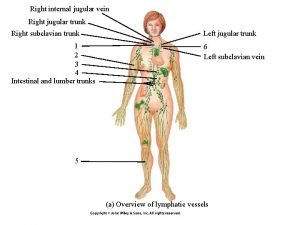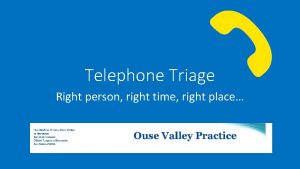lesson 10 2 DETERMINING RIGHT OF WAY AND





















- Slides: 21

lesson 10. 2 DETERMINING RIGHT OF WAY AND JUDGING GAPS Why do intersections naturally cause conflict? • Know how and when to yield the right of way. • Know how to judge the amount of space and time to enter traffic safely. The copyright holder has not granted permission to display this photograph in a downloadable format. You may view the photograph in the Drive Right Presentation for this lesson on your Keys to Teaching Success disc.

OBJECTIVE Define right of way.

What Is Right of Way? The term right of way describes the privilege of having immediate use of a certain part of a roadway. • You have the right of way only when other drivers give it to you. • It is not something you can take. • Laws determine who must yield.

• Yield when you want others to go first. • Yield to prevent a collision. • Yield to be courteous.

OBJECTIVE Describe situations in which the driver must yield the right of way.

Yielding the Right of Way Knowing the right-of-way laws will help you make safe decisions. Yield at STOP signs to • pedestrians in or near the crosswalk • all traffic on the through street

Yield at fresh green lights to • pedestrians still in the crosswalk • vehicles still in the intersection

Yield coming from an alley, driveway, or private roadway to • pedestrians before reaching the sidewalk • all vehicles on the street (Make two stops. )

Yield at all YIELD signs to • all pedestrians in or near crosswalks • all vehicles on the cross street

Yield to emergency vehicles • sounding a siren or using a flashing light (Stop clear of the intersection close to curb. Wait for emergency vehicle to pass. )

Yield when turning left at any intersection to • all pedestrians in your turn path • all oncoming vehicles that are at all close

Yield at four-way STOPs to • all pedestrians in or near crosswalks • vehicles that arrive first • a vehicle from the right if you arrive at the same time

Yield at uncontrolled intersections to • pedestrians in or near the crosswalk • any vehicle that has entered the intersection • a vehicle from the right if you both arrive at the same time

When deciding whether or not to yield, remember: • Do not cause those to whom you should yield to slow, stop, or change their path of travel. • Traffic signs only show who should yield the right of way. They do not stop traffic for you. • Do not assume others will always yield to you. • Many times it is better to yield the right of way even when the law requires the other driver to yield.

OBJECTIVE Predict how long it takes to cross and join traffic.

Judging the Size of a Gap Before entering a street after stopping, you must find and judge a large enough gap in traffic. 1. A gap is the distance between two vehicles. 2. Will you have time to enter or pass through traffic safely?

The size of gap that you need depends on the maneuver you plan to make and the speed of oncoming traffic. • Does it take more time to turn left, right, or pass through traffic? Gap Selection for Crossing or Joining Traffic

Joining Traffic Turning right or left into lanes of other traffic is joining traffic. • Accelerate to the speed of the through traffic without interfering with the flow of traffic. • The faster traffic is moving, the larger your gap must be.

• To turn right into traffic, you need a larger gap than you do to cross traffic. • Turning right and accelerating to 30 mph takes about six seconds.

• Why is turning left to join traffic more dangerous than turning right?

lesson 10. 2 review 1. What is meant by yielding the right of way? 2. List two factors that determine how big a gap must be before entering an intersection.
 Right product right place right time right price
Right product right place right time right price Family time
Family time The right man on the right place at the right time
The right man on the right place at the right time What's a frequency table
What's a frequency table Threaded trees
Threaded trees Perbedaan anova one way dan two way
Perbedaan anova one way dan two way Conventional software engineering
Conventional software engineering P and s wave arrival time chart
P and s wave arrival time chart What is the point estimate of μ?
What is the point estimate of μ? Problem 3-5 completing the accounting equation
Problem 3-5 completing the accounting equation Example of a claim of fact
Example of a claim of fact Perbedaan one way dan two way anova
Perbedaan one way dan two way anova Anova test
Anova test One way anova vs two way anova
One way anova vs two way anova Klasifikasi anova
Klasifikasi anova When i was one i had just begun the day i went to sea
When i was one i had just begun the day i went to sea Talk this way
Talk this way Loop whorl arch
Loop whorl arch Right of way herbicides
Right of way herbicides Right of way
Right of way There is no wrong way to do the right thing
There is no wrong way to do the right thing Right way to serve god
Right way to serve god








